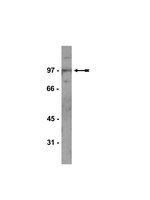Monoclonal antibodies to Kaiso: a novel transcription factor and p120ctn-binding protein.
Daniel, J M, et al.
Hybridoma, 20: 159-66 (2001)
2001
Show Abstract
The POZ-zinc finger protein Kaiso belongs to a rapidly growing superfamily of BTB/POZ zinc finger transcription factors implicated in embryonic development and cancer. Kaiso interacts with the catenin p120(ctn), but the significance of the interaction remains unknown. Although p120(ctn) is normally found in association with E-cadherin at cell-cell junctions, it can translocate to the nucleus under certain circumstances. Thus, the p120(ctn)-Kaiso interaction may regulate transcriptional events, as has been described previously for the classical catenin, beta-catenin and the LEF1/TCF transcription factor. To facilitate further study of Kaiso and to determine the physiological relevance of its interaction with p120(ctn), we have generated and characterized a panel of five Kaiso-specific monoclonal antibodies (MAbs) that function in immunoblotting, immunoprecipitation, and immunofluorescence analyses. | 11461664
 |
The p120 catenin partner Kaiso is a DNA methylation-dependent transcriptional repressor.
Prokhortchouk, A, et al.
Genes Dev., 15: 1613-8 (2001)
2001
Show Abstract
We describe a novel mammalian DNA binding activity that requires at least two symmetrically methylated CpG dinucleotides in its recognition sequence, preferably within the sequence 5'CGCG. A key component of the activity is Kaiso, a protein with POZ and zinc-finger domains that is known to associate with p120 catenin. We find that Kaiso behaves as a methylation-dependent transcriptional repressor in transient transfection assays. Kaiso is a constituent of one of two methyl-CpG binding complexes originally designated as MeCP1. The data suggest that zinc-finger motifs are responsible for DNA binding, and may therefore target repression to specific methylated regions of the genome. As Kaiso associates with p120 catenin, Kaiso may link events at the cell surface with DNA methylation-dependent gene silencing. | 11445535
 |
The catenin p120(ctn) interacts with Kaiso, a novel BTB/POZ domain zinc finger transcription factor.
Daniel, J M and Reynolds, A B
Mol. Cell. Biol., 19: 3614-23 (1999)
1999
Show Abstract
p120(ctn) is an Armadillo repeat domain protein with structural similarity to the cell adhesion cofactors beta-catenin and plakoglobin. All three proteins interact directly with the cytoplasmic domain of the transmembrane cell adhesion molecule E-cadherin; beta-catenin and plakoglobin bind a carboxy-terminal region in a mutually exclusive manner, while p120 binds the juxtamembrane region. Unlike beta-catenin and plakoglobin, p120 does not interact with alpha-catenin, the tumor suppressor adenomatous polyposis coli (APC), or the transcription factor Lef-1, suggesting that it has unique binding partners and plays a distinct role in the cadherin-catenin complex. Using p120 as bait, we conducted a yeast two-hybrid screen and identified a novel transcription factor which we named Kaiso. Kaiso's deduced amino acid sequence revealed an amino-terminal BTB/POZ protein-protein interaction domain and three carboxy-terminal zinc fingers of the C2H2 DNA-binding type. Kaiso thus belongs to a rapidly growing family of POZ-ZF transcription factors that include the Drosophila developmental regulators Tramtrak and Bric à brac, and the human oncoproteins BCL-6 and PLZF, which are causally linked to non-Hodgkins' lymphoma and acute promyelocytic leukemia, respectively. Monoclonal antibodies to Kaiso were generated and used to immunolocalize the protein and confirm the specificity of the p120-Kaiso interaction in mammalian cells. Kaiso specifically coprecipitated with a variety of p120-specific monoclonal antibodies but not with antibodies to alpha- or beta-catenin, E-cadherin, or APC. Like other POZ-ZF proteins, Kaiso localized to the nucleus and was associated with specific nuclear dots. Yeast two-hybrid interaction assays mapped the binding domains to Arm repeats 1 to 7 of p120 and the carboxy-terminal 200 amino acids of Kaiso. In addition, Kaiso homodimerized via its POZ domain but it did not heterodimerize with BCL-6, which heterodimerizes with PLZF. The involvement of POZ-ZF proteins in development and cancer makes Kaiso an interesting candidate for a downstream effector of cadherin and/or p120 signaling. | 10207085
 |










